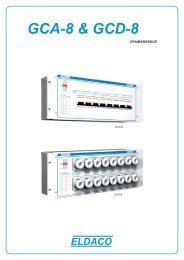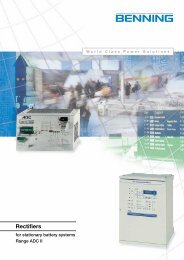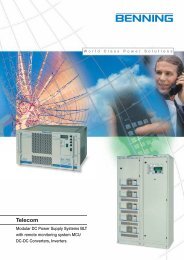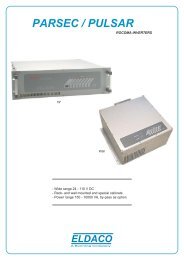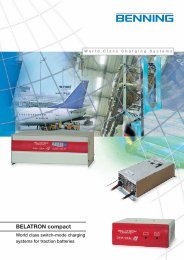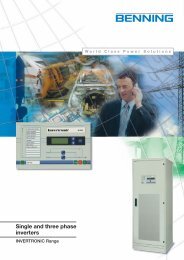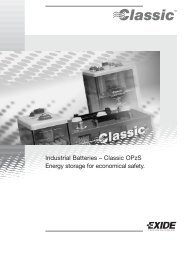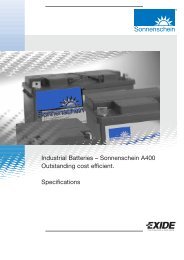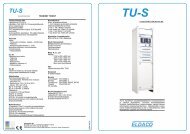Industrial UPS, single and three phase output
Industrial UPS, single and three phase output
Industrial UPS, single and three phase output
You also want an ePaper? Increase the reach of your titles
YUMPU automatically turns print PDFs into web optimized ePapers that Google loves.
World Class Power Solutions<br />
Internal power supply<br />
<strong>UPS</strong> mains operation<br />
<strong>UPS</strong> battery operation<br />
Bypass operation<br />
Parallel operation<br />
Manual bypass<br />
Overload<br />
Inverter failure<br />
Mains failure<br />
Battery voltage low<br />
ENERTRONIC I<br />
LED Test<br />
<strong>Industrial</strong> <strong>UPS</strong>, <strong>single</strong> <strong>and</strong><br />
<strong>three</strong> <strong>phase</strong> <strong>output</strong><br />
ENERTRONIC I Range
2<br />
BENNING World Class Power Solutions<br />
ENERTRONIC I<br />
disposed for highest security<br />
General<br />
The requirement for power supply reliability is growing, due<br />
to the increasing application of information <strong>and</strong> data carrier<br />
systems, text processing, automated production processes<br />
<strong>and</strong> complex data networks.<br />
Fig. 1: Possible Irregularities<br />
Irregularities due to loading of the public power supply by<br />
major users, peak-time use or by lightning strikes cannot be<br />
avoided.<br />
The result is:<br />
Mains voltage breaks, spikes <strong>and</strong> transients. (Fig. 1)<br />
Static <strong>UPS</strong>’s are being installed increasingly for loads that<br />
require AC voltages unaffected by interference on the<br />
mains e.g.<br />
• Data processing installations<br />
• Process control computers<br />
• Air safety installations<br />
• Signalling, alarm systems<br />
• Telecommunication systems<br />
• Power- <strong>and</strong> Substations<br />
Fig. 2: ENERTRONIC I <strong>UPS</strong><br />
Design<br />
Due to the use of IGBT transistors of the newest technology<br />
in the rectifier <strong>and</strong> in the inverter, the new ENERTRONIC I<br />
range fulfills the highest reliabilty for power supplies <strong>and</strong> is<br />
very economical.<br />
This results in an input power factor of ≥ 0,99 <strong>and</strong> an input<br />
distortion factor of < 5 %.<br />
The exceptional characteristics of this inverter in the<br />
ENERTRONIC I series results in very small dynamic voltage<br />
deviations even in the case of one hundred percent load<br />
changes.<br />
A combination of a 16-bit micro-controller <strong>and</strong> the latest<br />
power electronics is responsible for controlling <strong>and</strong> monitoring<br />
of all rectifier, inverter <strong>and</strong> static switch functions with highest<br />
reliability. A static switch <strong>and</strong> a manual bypass switch are<br />
integrated in the unit.<br />
In the front of the cabinet there is a plastic foil keyboard with<br />
6 keys, 4 <strong>three</strong> coloured <strong>and</strong> 2 <strong>single</strong> coloured LED’s <strong>and</strong> a<br />
mimic diagram.
BENNING World Class Power Solutions<br />
ENERTRONIC I<br />
an uninterrupptible power supply<br />
3<br />
Function<br />
The static <strong>UPS</strong> not only has the task of supplying the connected<br />
consumers continuously <strong>and</strong> without interruption, but beyond<br />
that to also provide a clear improvement of the voltage <strong>and</strong><br />
frequency quality in relation to the normal system. In normal<br />
operation the load is supplied by the input autotransformer,<br />
rectifier, inverter <strong>and</strong> <strong>output</strong> transformer route.<br />
The ENERTRONIC I is designed to meet the highest <strong>UPS</strong> classification<br />
VFI SS 111 in accordance with EN 62040-2.<br />
140 %<br />
120 %<br />
100 %<br />
80 %<br />
60 %<br />
40 %<br />
20 %<br />
0% 0 0,2 0,4 0,6 0,8 1 0,8 0,6 0,4 0,2 0<br />
leading power factor lagging<br />
Fig. 4: Available inverter apparent <strong>output</strong> power depending on<br />
power factor<br />
Fig. 3: Interior view<br />
Rectifier<br />
The rectifier consists of an IGBT bridge with power factor correction<br />
(power factor = 1), converting the <strong>three</strong> <strong>phase</strong> mains<br />
voltage via an autotransformer (optional isolated transformer)<br />
into a controlled DC voltage to supply the inverter <strong>and</strong> to<br />
recharge the connected battery or to keep the battery in optimum<br />
capacity in float charge condition.<br />
The rectifier is able to supply the fully loaded inverter <strong>and</strong> to<br />
recharge the discharged battery to 95 % of its capacity within<br />
12 hours.<br />
The rectifier is equipped with a software controlled soft start<br />
to start the rectifier on a ramp after mains failure.<br />
The restart of parallel systems is done in steps so that not all<br />
<strong>UPS</strong>’s are starting at the same time.<br />
The rectifier is also equipped with an IU charging characteristic<br />
in accordance with the information of the battery manufacturer,<br />
with the option of battery temperature compensation.<br />
Inverter<br />
The inverter power block changes DC voltage into a <strong>single</strong><br />
or <strong>three</strong> <strong>phase</strong> sinusoidal AC voltage with constant amplitude<br />
<strong>and</strong> stable frequency. The <strong>output</strong> voltage is independent of<br />
line disturbances or power failures.<br />
The unit works with an IGBT inverter bridge with pulse width<br />
modulation having a high efficiency in the partial load range<br />
as well as achieving a low distortion factor at non linear load.<br />
In the event of mains interruption or failure, the battery connected<br />
to the DC input is brought in automatically <strong>and</strong> without<br />
interruption to supply current. If the battery becomes<br />
discharged this is reported. If the battery discharge limit is<br />
exceeded, the inverter automatically turns off <strong>and</strong> a warning<br />
is given shortly before the discharged voltage limit is reached.<br />
Automatic change-over of the load to the bypass mains or<br />
a suitable spare supply occurs if the supply from the inverter<br />
falls outside the preset tolerances.
4<br />
BENNING World Class Power Solutions<br />
ENERTRONIC I<br />
multi utilities<br />
Static Bypass<br />
The static bypass of the <strong>UPS</strong> facilitates uninterrupted changeover<br />
to direct mains supply (bypass mains), keeping within the<br />
specified tolerances. The change-over can be initiated manually<br />
or automatically by a control signal. The µP monitoring is<br />
autonomous <strong>and</strong> prevents incorrect operation of the <strong>UPS</strong> <strong>and</strong><br />
any illogical switching functions of the static bypass.<br />
Thus, for example, an uninterrupted change-over, whether<br />
automatic or manual, is only possible when the voltage, frequency<br />
<strong>and</strong> <strong>phase</strong> conditions of the inverter are synchronised<br />
with the bypass mains. Mains frequency deviations, which lie<br />
outside the preset tolerances cause blocking of the changeover,<br />
or if the inverter fails, a change-over with an interruption.<br />
A change back can only occur to a functioning inverter, <strong>and</strong> is<br />
in everycase uninterrupted even if the mains should fail on a<br />
test change-over.<br />
The static bypass consists of a microprocessor-controlled<br />
anti parallel thyristor block. It can be activated manually with<br />
a push button, in order to test the change-over. The changeover<br />
from inverter to the mains <strong>and</strong> back takes place in a<br />
synchronised operation without a break.<br />
The static bypass has an overload capability of 150 % for<br />
10 min. <strong>and</strong> 500 % (<strong>single</strong> <strong>phase</strong> <strong>output</strong>) <strong>and</strong> 1000 % (<strong>three</strong><br />
<strong>phase</strong> <strong>output</strong>) for 100 ms.<br />
After the presence of an overload or a short-circuit, it automatically<br />
resets the load to the inverter, if normal operation is<br />
possible.<br />
man. bypass<br />
bypass<br />
input<br />
input<br />
breaker<br />
static bypass<br />
<strong>output</strong><br />
breaker<br />
<strong>UPS</strong><br />
<strong>output</strong><br />
mains<br />
input<br />
input<br />
contactor<br />
input<br />
transformer<br />
rectifier<br />
inverter<br />
battery<br />
(external)<br />
<strong>output</strong><br />
transformer<br />
<strong>output</strong><br />
contactor<br />
Fig. 5: Block diagram<br />
Internal manual bypass<br />
Each <strong>UPS</strong> is equipped with a maintenance bypass with<br />
manually operated switch. When operated, the ENERTRONIC I<br />
is completely disconnected from the load. The supply to the<br />
load is now directly from the mains via the manual bypass.<br />
(Fig. 5)<br />
Parallel Operation<br />
For redundancy or increased <strong>output</strong> power, up to eight<br />
ENERTRONIC I units can be connected in parallel, operating in<br />
an active load-sharing mode with active <strong>and</strong> passive master.<br />
Half load parallel operation is achieved using two separate<br />
bus bars, connected with a coupling switch. The state of the<br />
coupling switch is relayed to the microprocessor, via an<br />
auxiliary contact.<br />
Option<br />
For power plant applications where higher than normal fault<br />
<strong>three</strong> <strong>phase</strong> clearing current is required, it is possible to<br />
specify an option for 4 x I nominal system <strong>output</strong>. Depending<br />
on the <strong>output</strong> power, a bigger cabinet may be required.
5<br />
BENNING World Class Power Solutions<br />
ENERTRONIC I<br />
all-purpose<br />
Technical Data<br />
ENERTRONIC I 3-1 with <strong>three</strong> <strong>phase</strong> input <strong>and</strong> <strong>single</strong> <strong>phase</strong> <strong>output</strong> - DIN Type: D400 E230/...../2 rfg-WEG....<br />
Nominal power cos. ϕ 0,8: [kVA] 30, 40, 50, 60, 80, 100, 120<br />
Type ENERTRONIC I<br />
<strong>UPS</strong> Nominal <strong>output</strong> power (cos. ϕ=0,8 ind.): [kVA] 30 40 50 60 80 100 120<br />
Inverter data<br />
ENERTRONIC I 3-1<br />
Inverter input voltage: 187 - 264<br />
Nominal input real power<br />
(with load cos. ϕ=0,8 ind.):<br />
[kW] 25,5 34,4 42,5 51,1 68,1 - -<br />
Nominal <strong>output</strong> real power (cos. ϕ=1): [kW] 24 32 40 48 64 - -<br />
Nominal <strong>output</strong> current (cos. ϕ=0,8): [A] 130 173 217 260 347 - -<br />
Nominal <strong>output</strong> current (cos. ϕ=1): [A] 104 139 173 208 278 - -<br />
Nominal <strong>output</strong> voltage: 230 V (adjustable ± 5%)<br />
Nominal <strong>output</strong> frequency: [Hz] 50<br />
Transformer:<br />
galvanically isolated<br />
Voltage tolerance:<br />
- static [%] ± 1<br />
- dynamic with 100% load change [%] < 5<br />
Regulation time: [msec] < 10<br />
Angle deviation: < 1°<br />
Frequency tolerance:<br />
- mains synchronised [%] ± 1 (synchronisation range ± 4)<br />
- self synchronised [%] ± 0,1<br />
Distortion factor (acc. EN 62040-1):<br />
- linear load [%] < 1<br />
- non linear load [%] < 5<br />
Crest factor: ≥ 3<br />
Overload:<br />
150% 60 sec., 125% 10 min.<br />
Short-circuit behaviour:<br />
300% 3 sec.<br />
Inverter itself is short circuit proof, switch OFF after<br />
max. 3 seconds if bypass mains is not available (EN 62040)<br />
Inverter efficiency<br />
with nominal load (cos. ϕ 0,8):<br />
[%] ≥ 92 ≥ 94<br />
Front Panel<br />
The operation of the <strong>UPS</strong> is made by a plastic foil keyboard<br />
with 6 keys, 4 <strong>three</strong> coloured <strong>and</strong> 2 <strong>single</strong> coloured LED’s.<br />
There is a mimic diagram on the operating section. The<br />
operating condition <strong>and</strong> any operational disturbances are represented<br />
by the multi colour LED’s. (Fig. 6)<br />
Internal power supply<br />
<strong>UPS</strong> mains operation<br />
<strong>UPS</strong> battery operation<br />
Bypass operation<br />
Parallel operation<br />
Manual bypass<br />
Overload<br />
Inverter failure<br />
Mains failure<br />
Battery voltage low<br />
LED Test<br />
Fig. 6: Front Panel<br />
ENERTRONIC I<br />
There is a 4-line, 80-digit LC display in the operating section<br />
for reading information <strong>and</strong>/or for clear guidance by the<br />
menu. Control of the operating section takes place via the<br />
display controller, which communicates over the CAN bus<br />
with the controller board.<br />
In addition, the most important operating <strong>and</strong> fault signals<br />
are indicated by 13 <strong>single</strong> LED’s.<br />
Rectifier:<br />
· input voltage<br />
(each <strong>phase</strong>/<strong>phase</strong> or<br />
<strong>phase</strong>/neutral conductor)<br />
Inverter:<br />
· <strong>output</strong> voltage (with<br />
<strong>three</strong> <strong>phase</strong> <strong>output</strong><br />
<strong>phase</strong>/<strong>phase</strong> or <strong>phase</strong>/<br />
neutral conductor)<br />
· frequency<br />
· input current of each <strong>phase</strong><br />
· frequency<br />
· <strong>output</strong> current (with<br />
<strong>three</strong> <strong>phase</strong> <strong>output</strong><br />
of each <strong>phase</strong>)<br />
· apparent power<br />
· real power
BENNING World Class Power Solutions<br />
ENERTRONIC I<br />
all-purpose<br />
6<br />
Technical Data<br />
ENERTRONIC I 3-3 with <strong>three</strong> <strong>phase</strong> input <strong>and</strong> <strong>three</strong> <strong>phase</strong> <strong>output</strong> - DIN Type: D400 D400/...../2 rfg-WDG....<br />
Nominal power cos. ϕ 0,8: [kVA] 30, 40, 50, 60, 80, 100, 120<br />
Type ENERTRONIC I<br />
<strong>UPS</strong> Nominal <strong>output</strong> power (cos. ϕ=0,8 ind.): [kVA] 30 40 50 60 80 100 120<br />
Inverter data<br />
ENERTRONIC I 3-3<br />
Inverter input voltage: 187 - 264<br />
Nominal input real power<br />
(with load cos. ϕ=0,8 ind.):<br />
[kW] 25,5 34,4 42,5 51,1 68,1 85,1 102<br />
Nominal <strong>output</strong> real power (cos. ϕ=1): [kW] 24 32 40 48 64 80 96<br />
Nominal <strong>output</strong> current (cos. ϕ=0,8): [A] 43,3 57,7 72,1 86,6 115 144 173<br />
Nominal <strong>output</strong> current (cos. ϕ=1): [A] 34,6 46,2 57,7 69,3 92,4 115 138<br />
Nominal <strong>output</strong> voltage: 3/N 400 V (adjustable ± 5%)<br />
Nominal <strong>output</strong> frequency: [Hz] 50<br />
Transformer:<br />
galvanically isolated<br />
Voltage tolerance:<br />
- static [%] ± 1<br />
- 50% asymmetric load [%] ± 1<br />
- 100% asymmetric load [%] ± 3<br />
- dynamic with 100% load change [%] < 5<br />
Regulation time: [msec] < 10<br />
Angle deviation:<br />
- symmetric load < 1°<br />
- 50% asymmetric load < 2°<br />
- 100% asymmetric load < 3°<br />
Frequency tolerance: - mains synchronised [%] ± 1 (synchronisation range ± 4)<br />
- self synchronised [%] ± 0,1<br />
Distortion factor (acc. EN 62040-1): - linear load [%] < 1<br />
- non linear load [%] < 5<br />
Crest factor: ≥ 3<br />
Overload: - 3ph<br />
150% 60 sec., 125% 10 min.<br />
- 1ph / N 220% 60 sec., 180% 10 min.<br />
Short-circuit behaviour: - 3ph<br />
200% 3 sec.<br />
- 1ph / N 350% 3 sec.<br />
Inverter itself is short circuit proof, switch OFF after<br />
max. 3 seconds if bypass mains is not available (EN 62040)<br />
Inverter efficiency<br />
with nominal load (cos. ϕ 0,8):<br />
[%] ≥ 92 ≥ 94<br />
Battery:<br />
· voltage<br />
· charge/discharge current<br />
Bypass:<br />
· input voltage (with<br />
<strong>three</strong> <strong>phase</strong> <strong>output</strong><br />
<strong>phase</strong>/<strong>phase</strong> or <strong>phase</strong>/<br />
neutral conductor)<br />
· remaining back up time<br />
· remaining capacity<br />
· input current (with <strong>three</strong><br />
<strong>phase</strong> <strong>output</strong> of each<br />
<strong>phase</strong>)<br />
· frequency<br />
An event recorder stores each occurring event (push button<br />
operation, switching events <strong>and</strong> error) with date <strong>and</strong> time. Up<br />
to 1200 entries can be stored.<br />
The following information is indicated via 6 volt free change<br />
over contacts:<br />
· mains operation (mains OK) · manual bypass activated<br />
· battery operation · low battery voltage<br />
· bypass operation · common alarm<br />
As serial interfaces a RS232 <strong>and</strong> RS485 each with MODBus<br />
protocol is provided as st<strong>and</strong>ard, additionally an analogue <strong>output</strong><br />
with 0 or 4 to 20 mA is included which can be programmed<br />
with an internal value, e.g. <strong>output</strong> power.<br />
Digital inputs:<br />
· EMERGENCY POWER · inhibit battery charging<br />
OFF (EPO)<br />
· generator operation<br />
· remote ON/OFF · inhibit bypass operation<br />
As an option an additional relay card with 6 relays <strong>and</strong> an<br />
additional interface card with a RS232 <strong>and</strong> RS485 can be build<br />
in, also a Profibus interface <strong>and</strong> network interface (TCP/IP)<br />
can be added.
BENNING World Class Power Solutions<br />
ENERTRONIC I<br />
General data<br />
7<br />
Technical Data<br />
Type ENERTRONIC I<br />
<strong>UPS</strong> Nominal <strong>output</strong> power (cos. ϕ=0,8 ind.): [kVA] 30 40 50 60 80 100 120<br />
Rectifier data<br />
ENERTRONIC I 3-1 <strong>and</strong> 3-3<br />
Max. input power: [kVA] 32,7 43,5 54,4 65,2 78,1 108 129<br />
Nominal input power without battery charging: [kVA] 27,2 36,2 45,3 54,3 72,2 90,2 108<br />
Nominal input current without battery charging (at 400 V): [A] 39,2 52,3 65,4 78,4 104 130 155<br />
Max. input current with high rate charging (at 400 V): [A] 47,2 62,8 78,5 94,1 112 155 186<br />
Transformer:<br />
autotransformer (optional galvanically isolated)<br />
Input power factor: ≥ 0,99 ( 0,97 already at 25% load )<br />
Nominal input voltage: 3/N 400 V ± 15%<br />
Nominal input frequency: 50 Hz ± 5%<br />
Mains distortion (at 100% load): [%] ≤ 5<br />
Current ripple:<br />
< 5 A / 100 Ah<br />
Battery data<br />
Recommended number of battery cells: 106 - 116<br />
Max. charging current: [A] 20 27 34 41 55 69 83<br />
General data<br />
Over all efficiency (AC to AC) without battery charging:<br />
- 100% load 88,4 88,4 88,4 88,4 88,7 88,5 88,5<br />
- 75% load 88,7 88,7 88,7 88,7 89,1 88,9 88,9<br />
- 50% load 89,0 89,0 89,0 89,0 89,5 89,1 89,1<br />
Heat dissipation: - 100% load [kW] 3,2 4,2 5,2 6,3 8,4 10,4 12,6<br />
Noise level with 1 m distance: [dB(A)] 63 65 67<br />
Permitted ambient temp.: [°C] 0 to +40 (daily average ≤ 35)<br />
Relative humidity: [%] 5 - 95 without condensing<br />
Permitted installation height: [m] < 1000 m above sea level without derating<br />
Humidity class: DIN/IEC 721 2-1-09/86<br />
Protection degree:<br />
IP 20 (DIN/VDE 0470 part 11/92 IEC 529) / others optional<br />
Radio interference: EN 50091-2 st<strong>and</strong>ard class A (optional class B)<br />
Dimensions (Width x Depth x Height): [mm] 800 x 800 x 2000 (optional 2200 height)<br />
(max. 30 kVA <strong>single</strong> <strong>phase</strong> <strong>and</strong> 60 kVA <strong>three</strong> <strong>phase</strong> <strong>output</strong>)<br />
[mm]<br />
1600 x 800 x 2000 (optional 2200 height)<br />
(max. 80 kVA <strong>single</strong> <strong>phase</strong> <strong>and</strong> 120 kVA <strong>three</strong> <strong>phase</strong> <strong>output</strong>)<br />
Cooling: forced cooled with speed controlled, redundant <strong>and</strong> monitored fans, build in the air inlet, equipped with air flaps,<br />
which close in case of fan failure, fans can be changed from front, power blocks <strong>and</strong> transformers are temperature<br />
monitored, prewarning will be sent out, after temperature increase switch OFF, air inlet from front, air outlet from top<br />
Cable entry:<br />
from bottom (optional from top with cable cabinet, width 200 mm)<br />
Painting:<br />
RAL 7035, structured power coating<br />
Static bypass<br />
Nominal voltage: [V] 230 / 400<br />
Nominal frequency: [Hz] 50<br />
Over load: - 10 min. [%] 150<br />
- 100 msec. [%] ENERTRONIC I 3-1: 500, ENERTRONIC I 3-3: 1000<br />
Transfer limits: [%] U ± 10; F ± 5<br />
Inverter/Bypass transfer time:<br />
- inverter failure [msec] < 1<br />
- overload or manual transfer [msec] < 1<br />
interlock when transfer was activated 5 times within a minute<br />
Bypass/inverter transfer time: [msec] < 1<br />
Other options, e.g. bypass transformer on request.
BENNING World Class Power Solutions<br />
www.benning.de<br />
BENNING worldwide<br />
Austria<br />
Benning GmbH Elektrotechnik und Elektronik<br />
Eduard-Klinger-Str. 9<br />
A-3423 St. Andrä-Wördern<br />
Tel. 0 22 42 / 3 24 16-0<br />
Fax 0 22 42 / 3 24 23<br />
E-Mail: info@benning.at<br />
Hungary<br />
Benning Kft.<br />
Power Electronics<br />
Rákóczi út 145<br />
H-2541 Lábatlan<br />
Tel. 033/507600<br />
Fax 033/507601<br />
E-Mail: benning@vnet.hu<br />
South East Asia<br />
Benning Power Electronics Pte Ltd<br />
1, Kaki Bukit View<br />
# 05-03/04 Techview<br />
SGP-Singapore 415941<br />
Tel. (65) 6844 3133<br />
Fax (65) 6844 3279<br />
E-Mail: sales@benning.com.sg<br />
Belarus<br />
Benning IOOO<br />
ul. Sovetskaja 95-46<br />
BY-224030 Brest<br />
Tel. 0162 / 21 87 60<br />
Fax 0162 / 21 87 60<br />
E-Mail: info@benning.brest.by<br />
Irel<strong>and</strong><br />
Theo Benning GmbH<br />
North <strong>Industrial</strong> Estate<br />
Whitemill North<br />
IRE-Wexford / Rep. Irel<strong>and</strong><br />
Tel. 0 53 / 76 90 0<br />
Fax 053/41841<br />
E-Mail: benning@benning.ie<br />
Sweden<br />
Eldaco AB<br />
Box 990, Hovslagarev. 3B<br />
S-19129 Sollentuna<br />
Tel. 08 / 6239500<br />
Fax 08 / 969772<br />
E-Mail: power@eldaco.se<br />
Belgium<br />
Benning Belgium<br />
Power Electronics<br />
Z. 2 Essenestraat 16<br />
B-1740 Ternat<br />
Tel. 02 / 58 287 85<br />
Fax 02 / 58 287 69<br />
E-Mail: info@benning.be<br />
Italy<br />
Benning Conversione di Energia S.r.L<br />
Via 2 Giugno 1946, 8/B<br />
I-40033 Casalecchio di Reno (BO)<br />
Tel. 0 51 / 75 88 00<br />
Fax 0 51 / 61 67 655<br />
E-Mail: benning.energia@libero.it<br />
Switzerl<strong>and</strong><br />
Benning Power Electronics GmbH<br />
Industriestrasse 6<br />
CH-8305 Dietlikon<br />
Tel. 044 / 8057575<br />
Fax 044 / 8057580<br />
E-Mail: info@benning.ch<br />
Croatia<br />
Benning Zagreb<br />
Hrvatska<br />
Zeleni trg 3 b<br />
HR-10000 Zagreb<br />
Tel. 1 / 61 97 059<br />
Fax 1/6197060<br />
E-Mail: benning.zg@zg.t-com.hr<br />
Netherl<strong>and</strong>s<br />
Benning NL<br />
Power Electronics<br />
Peppelkade 42<br />
NL-3992 AK Houten<br />
Tel. 030/6346010<br />
Fax 0 30 / 6 34 60 20<br />
E-Mail: info@benning.nl<br />
Spain<br />
Benning Conversión de Energía S.A.<br />
C/Pico de Santa Catalina 2<br />
Pol. Ind. Los Linares<br />
E-28970 Humanes, Madrid<br />
Tel. 91/ 6048110<br />
Fax 91/ 6048402<br />
E-Mail: benning@benning.es<br />
ISO 14001<br />
Czech Republic<br />
Benning CR s.r.o.<br />
Zahradní ul. 894<br />
CZ-293 06 Kosmonosy<br />
(Mladá Boleslav)<br />
Tel. 326721003<br />
Fax 3 26 72 25 33<br />
E-Mail: benning@benning.cz<br />
France<br />
Benning Conversion d’énergie<br />
43, avenue Winston Churchill<br />
B.P. 418<br />
F-27404 Louviers Cedex<br />
Tél. 0 / 2.32.25.23.94<br />
Fax 0 / 2.32.25.08.64<br />
E-Mail: info@benning.fr<br />
Germany<br />
Theo Benning<br />
Elektrotechnik und Elektronik GmbH & Co.KG<br />
Münsterstr. 135-137<br />
D-46397 Bocholt<br />
Tel. 0 28 71/ 93-0<br />
Fax 02871/93297<br />
E-Mail: info@benning.de<br />
Great-Britain<br />
Benning Power Electronics (UK) Ltd.<br />
Oakley House<br />
Hogwood Lane<br />
Finchampstead<br />
GB-Berkshire<br />
RG 40 4QW<br />
Tel. 0118 9731506<br />
Fax 0118 9731508<br />
E-Mail: info@benninguk.com<br />
Pol<strong>and</strong><br />
Benning Power Electronics Sp.z.o.o.<br />
Korczunkowa 30<br />
PL-05-503 Glosków<br />
Tel. 0 22 / 7 57 84 53 / 7 57 36 68-70<br />
Fax 0 22 / 7 57 84 52<br />
E-Mail: biuro@benning.biz<br />
P. R. of China<br />
Benning Power Electronics (Beijing) Co., Ltd.<br />
Tongzhou <strong>Industrial</strong> Development Zone<br />
No. 1 Beier Str.<br />
PRC-101113 Beijing<br />
Tel. 10 69574995<br />
Fax 10 69574996<br />
E-Mail: info@benning.cn<br />
Russian Federation<br />
OOO Benning Power Electronics<br />
Scholkovskoje Chaussee, 5<br />
RF-105122 Moscow<br />
Tel. 095/9676850<br />
Fax 0 95 / 9 67 68 51<br />
E-Mail: benning@benning.ru<br />
Slovakia<br />
Benning Slovensko, s.r.o.<br />
Kukuričná 17<br />
SK-83103 Bratislava<br />
Tel. 02 / 44459942<br />
Fax 02 / 44455005<br />
E-Mail: benning@benning.sk<br />
Ukraine<br />
Benning<br />
ul. Solomenskaja, 3B<br />
UA-03110 Kiew<br />
Tel. 044 / 246 10 25<br />
Fax 044 / 248 92 36<br />
E-Mail: benning@benning.com.ua<br />
U.S.A.<br />
Benning Power Electronics, Inc.<br />
11120 Grader Street<br />
USA-Dallas, TX 75238<br />
Tel. 214 5531444<br />
Fax 214 5531355<br />
E-Mail: sales@benning.us<br />
784370.01 GB 08/2005 paus Design & Medien, Bocholt Subject to alterations. Printed on chlorine free paper.



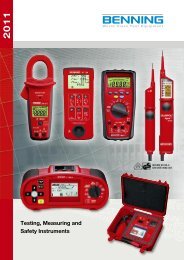
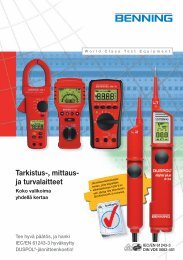
![2008-03-03 Ãbersichten [de-en-ru-fr].indd](https://img.yumpu.com/27509296/1/184x260/2008-03-03-abersichten-de-en-ru-frindd.jpg?quality=85)
